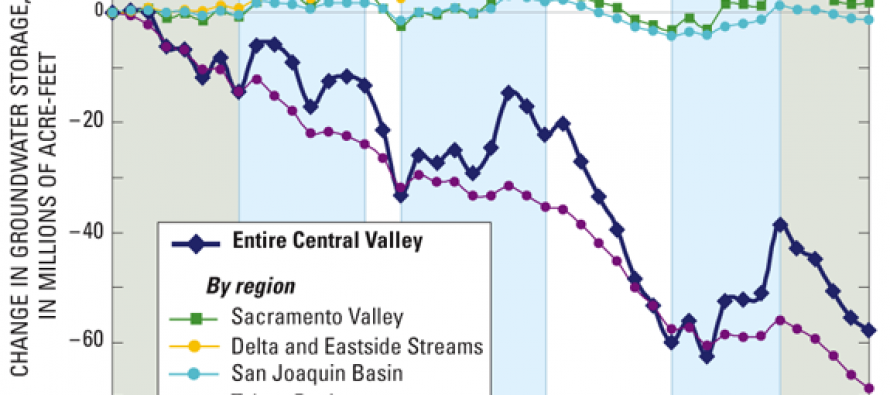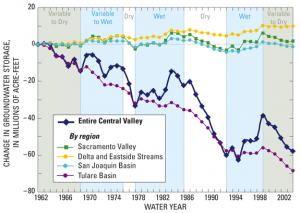Groundwater war breaks out

 Future historians might mark July 20 as the date when a full scale war broke out over California’s groundwater.
Future historians might mark July 20 as the date when a full scale war broke out over California’s groundwater.
On July 20 in the Los Angeles Times, George Skelton, the dean of California journalists, said it was unfair to tell him he can’t hose off his driveway or water his lawn while farmers can use all the groundwater they want. And he called for a coalition to legally absolve state property and water rights law going back a century.
He quoted state Sen. Fran Pavley, D-Agoura Hills, who said:
“California property owners have the right to all the water under them. That began in the Wild West. And we haven’t adapted to modern times…. It’s competition between property owners who get the most water. I call it a race to the to bottom.”
Pavley and Assemblyman Roger Dickinson, D-Sacramento, are sponsoring separate bills in the Legislature to increase state government control over groundwater.
Santa Barbara water rights advocate Andy Caldwell reacted on July 24 on a radio program on AM 1290. Caldwell said such an action scared him because agriculture is the mainstay of the economy of most central and coastal counties.
So this could turn out to be another state battle pitting farmers against city folk.
Wild West water shootout?
So what’s going on?
California does not have a groundwater permits process for groundwater use, instead preferring regulation by court adjudication and monitoring of groundwater basins at the local level.
California Groundwater law goes back not to Wild West shootouts, but to a 1903 legal case, Katz vs. Walkinshaw. In that case, the California Supreme Court established the groundwater rights of the overlying landowner are paramount over rights of others for use outside a basin.
Any new regulation of groundwater in California likely would require ratification by the state Supreme Court, or possibly the passage a state constitutional amendment by the Legislature or voters.
So agricultural groundwater is not regulated in California, but it is managed. After the passage of Assembly Bill 3030 in 1992 (Water Code Section 10750 et seq.), 200 water agencies and districts adopted groundwater management plans. The Department of Water Resources reports that groundwater is already monitored in 10,000 active water wells where most of the water is used.
The major difference between voluntary local government groundwater management and state regulation is that the state has the power to issue shutdown notices and compel compliance with law enforcement to conserve water. But is the latter necessary? In fact, water levels in aquifers have always rebounded, as shown in the above table.
There still are some areas of the state that have not adopted such management plans. Liability issues, the high cost of adjudicating water basins, the ability of farmers to self-manage groundwater levels, the complexities of existing water rights, and the lack of legal conflicts over local groundwater usage have made groundwater regulation unnecessary in many areas.
Groundwater is not generally monitored in some 200 water basins where the population is sparse and groundwater withdrawals are typically low. Moreover, it is not possible to convey groundwater from isolated aquifers to George Skelton to hose off his driveway.
Never Let A Groundwater Crisis Go to Waste
President Obama’s first chief of staff, current Chicago Mayor Rahm Emanuel, famously said, “You never let a serious crisis go to waste. And what I mean by that it’s an opportunity to do things you think you could not do before.”
Echoing that, Dickinson said about the drought (as quoted by Skelton), “Never let a good crisis go to waste.” As with the Emanuel, Dickinson meant using the crisis to increase government control.
According to Skelton’s analysis:
“Over the last century, the Central Valley has lost enough groundwater to fill Lake Tahoe — or enough to inundate the entire state by 14 inches. Between 2003 and 2009 alone, it lost enough to fill Lake Mead. The aquifer has fallen hundreds of feet in some areas, and not just in the San Joaquin Valley…. In the San Joaquin, land has been sinking with the aquifers.”
But again, as seen in the table above, water basins in the Sacramento, Delta, and San Joaquin basins never became depleted — even in the severe drought of 1977. The depletion of groundwater in the Central Valley is isolated to the Tulare Basin.
Even there, as of 2000 the Tulare aquifer had 390 years of remaining water storage left and was depleting at a rate of only 0.25 percent per year, according to a 2012 study conducted under the sponsorship of the National Academy of Sciences.
If California’s Water Wars really are beginning, it’s worth noting that groundwater in California is not part of a Wild West shootout, but a modern, mature system of management and adjudication.
Related Articles
Civil liberty groups fighting license suspensions for those guilty of “being poor”
A band of civil liberties groups are demanding that California courts stop suspending drivers licenses for failure to pay traffic fines,
Electric vehicle sales survive low gas prices — so far
Call it the Tesla Effect. Good news — so far — for California’s successful electric-vehicle maker and others in the
Unions Might Seek 43% Tax Increase
JULY 10, 2011 By JOHN SEILER California’s government unions could seek a 43 percent tax increase on wealthy Californians. The Contra




